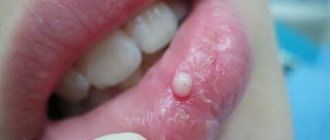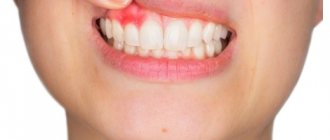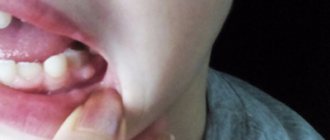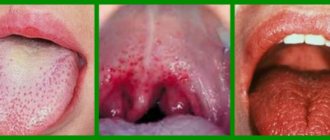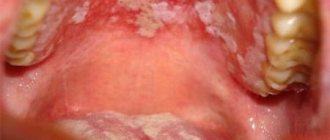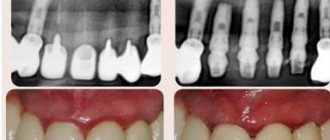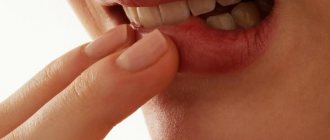Bumps in the mouth: what they are, their causes and treatment
Any neoplasms in the oral cavity require careful study of the clinical picture. This can be either a harmless growth or an alarming signal from the body. Thus, a lump on the roof of the mouth often occurs as a result of a cold or infection. This formation does not cause discomfort and resolves on its own after strengthening the immune system. If the growth is accompanied by pain and other unpleasant symptoms, this may indicate a serious pathology. Only a doctor can determine the cause of the lump and tell you what to do.
Causes
Angioma in the mouth is a congenital pathology, although it can also occur in adults. The main cause of the development of the disease is considered to be the proliferation of the vascular network. A tumor also forms after mechanical damage to the tissues of the palate, against the background of malignant processes in the body.
Treatment of angioma
Angioma is a group of benign neoplasms in the formation of which blood and lymphatic vessels take part.
It is also worth highlighting factors that increase the likelihood of the disease occurring, such as:
- Smoking, alcohol abuse.
- Availability of dentures .
- Intrauterine abnormal processes during embryo formation.
- Infectious infection.
- The presence of various dental pathologies.
The exact cause will be determined when visiting an otolaryngologist. Angioma can have serious consequences, so it is important not to delay a visit to a specialist.
Why do bumps appear in the sky?
A growth in the mouth appears as a result of blockage of blood vessels and stagnation of organic fluids, which causes inflammation in the mucosal tissues. Among the most common causes of pathology are the following:
- bad habits – alcohol abuse and smoking;
- chronic diseases – sore throat, sinusitis;
- constant exposure to traumatic factors - incorrectly fitted crowns that become infected, eating too hot food, sucking on lollipops, etc.;
- insufficient oral hygiene - food remains behind the teeth become a favorable environment for the development of pathogenic microflora;
- inflammation of the salivary glands;
- colds and infectious diseases;
- Doctor’s mistakes – incorrect filling or tooth extraction.
A child can also develop a lump in the mouth. In most cases, the pathology occurs due to bruises, which are quite common in childhood.
Bumps also form in the mouth due to cancer (leukoplakia and papillomatosis), which pose a great danger to human health and life.
Treatment
After making an accurate diagnosis, a type of treatment is selected aimed at eliminating the disease and protecting against complications. Angiomas on the palate can be eliminated using various methods of therapy.
Self-medication is dangerous with complications!
Attention
Despite the fact that our articles are based on trusted sources and have been tested by practicing doctors, the same symptoms can be signs of different diseases, and the disease may not proceed according to the textbook.
Pros of seeing a doctor:
- Only a specialist will prescribe suitable medications.
- Recovery will be easier and faster.
- The doctor will monitor the course of the disease and help avoid complications.
find a doctor
Do not try to treat yourself - consult a specialist.
Sclerosis
The use of vasoconstrictors can significantly reduce the size of the tumor. 70% ethyl alcohol, injected into the tumor in the form of injections, is excellent for this purpose.
In most cases, sclerotherapy is used as preparation for radical surgery. In addition, this method causes severe swelling of the larynx, so the use of ethyl alcohol to reduce the lump is not recommended for everyone.
Cryodestruction
Despite the modernity and effectiveness of this technique, cryotherapy is prescribed extremely rarely. This is due to the risk of burns to tissue structures. Moreover, it is impossible to control the area of treatment with liquid nitrogen, which can cause damage to the healthy oral mucosa.
Electrocoagulation
The essence of this procedure is to cauterize the tumor. For this purpose, a high-frequency electrical pulse is used. After the procedure, the pathological cells die. Laser therapy is also used to improve results.
Laser treatment
This treatment method is considered the most popular. Laser therapy is characterized by the absence of bleeding and damage to adjacent healthy tissues.
Thanks to this method, the lump is removed layer by layer and almost painlessly. Moreover, after using the laser, the recovery period is accelerated.
Radium treatment
This modern technique is extremely effective for eliminating capillary angioma. However, in the treatment of cavernous tumors, radium therapy does not produce any results.
General symptoms
A tumor formed in the oral cavity can be of different colors: white, dark red, blue, transparent yellow. Sometimes it is soft, in other cases it is dense. A lump that appears against the background of one pathology may differ depending on the individual characteristics of the patient’s body: age, general condition of his body, bad habits, etc.
The lump appears in the form of a bubble, growth, ball, compaction, tumor with faint edges. Spots (change in color of the mucous membrane) may also form in the affected area. In some cases, numbness is felt in a certain part of the oral cavity, difficulties appear when swallowing, and the voice changes. In advanced forms of the disease, the cones may be damaged, which provokes bleeding with an unpleasant taste and odor.
Painful lumps indicate inflammation and suppuration. General health worsens, body temperature may rise. Purulent intoxication of the body occurs. In this case, the lump grows, it becomes hard and hot, and the regional lymph nodes enlarge.
Diagnosis of diseases accompanied by the formation of lumps in the mouth
Tumors have appeared in the mouth, and the question is, which doctor should I contact? This symptom is a prerequisite for visiting the dentist. To diagnose the disease, the doctor will first conduct a visual examination and palpation, and collect an anamnesis. A puncture is taken from the resulting lump and a bacteriological examination is carried out, which makes it possible to determine the cause of its occurrence.
Based on the results obtained, the doctor determines the need to use other diagnostic methods:
- general tests;
- X-ray;
- Ultrasound;
- biopsy.
If the cause of the formation of a lump on the upper palate is beyond the scope of the dentist’s competence, the patient is prescribed consultations with other specialists (pediatrician, therapist, gastroenterologist, endocrinologist, hepatologist). Only after making a diagnosis will the doctor determine how to treat the disease.
Preliminary determination of lump symptoms
A lump on the palate is the cause of a dental disease or inflammatory process. Each type of growth has its own causes and subtleties of symptoms, and therefore requires separate consideration.
Angioma
Angioma is a tumor in the palate caused by disruption of processes in the tissues of the blood vessels of the soft palate. The shape of the cone resembles a rolled corkscrew. The tubercle has a blue or purplish-black characteristic color. The ball is a product of a disorder in the development of blood vessels, so the color is caused by the excess amount of blood in the formation.
Photos of characteristic signs of angioma
Pressure causes bleeding, which should not be experimented with. There is a pulsating response to pressing .
Such a lump on the upper palate is life-threatening for the patient. Bleeding is difficult to stop, and large blood loss is fatal.
At the first signs of such compaction, you must seek qualified help.
Cyst
Photo of a cyst on the palate
A lump in the mouth on the palate is classified as a cyst when a hard ball appears on the palate and its size does not exceed 12 cm. The cyst appears due to a disorder of the sebaceous glands. It won’t hurt, but it will make it significantly more difficult to eat, and then completely disrupt the correct functioning of these secretions.
A cyst on the palate requires surgery and can only be treated with it.
Pemphigus
Photo of pemphigus on the sky
Children are most susceptible to developing pemphigus. It pops up in the shape of a white ball at the top of the mouth. The bumps are a consequence of erosion and later develop into ulcers. When pressed it bleeds and hurts. Diagnosed by visual examination and using the Nikolsky method.
If the tumor is not removed, erosion will develop into massive exfoliation of the oral epithelium, disruption of digestive processes, and general weakness. If there is no treatment, the bumps become widespread . Pressure causes rupture of tumors, the contents of which cause intoxication of the body.
Myxoma
A myxioma is a hard, white growth at the top of the mouth. The disease affects the hard part of the palate, and upon visual examination it is almost invisible; pressure on the tumor is not felt. This significantly complicates diagnosis and delays the patient’s visit to the doctor.
The diagnosis can be confirmed or refuted by a biopsy of the palate.
Oncological disease
Cancerous lump is classified into two diseases:
- Hard palate cancer - starting from the bone tissue between the nasopharynx and the palate, the disease spreads to all mucosal tissues.
- Cancer of the soft palate - a lump appears due to an oncological process in the muscle and mucous tissues of the mouth.
Additionally, the oncological tubercle on the roof of the mouth is divided according to the tissue from which the spread of the disease began:
- Cylinder - the maternal tissue is the tissue of the glands, the cancer spreads quickly and invades the oral cavity;
- Adenocarcinoma - begins expansion of the mouth from the soft tissues of the cavity;
- Squamous cell carcinoma is a malignant formation that begins to develop from the tissues of the mucous membrane.
Dental diseases
At an advanced stage of periodontitis, a fistula forms near the tooth involved in the painful process. If periostitis (inflammation of the periosteum) develops, flux may appear. At first the lump is hard, but over time it becomes softer and filled with pus.
In case of periodontitis, the tooth is unfilled and the root canals are cleaned. After removing the exudate, oral baths are prescribed using special solutions. In case of periostitis, the dentist opens the tooth, places medications in the cavity, and closes it with a temporary filling. If this treatment does not help, the tooth is removed.
Angioma
It is a benign formation, which in most cases is a congenital pathology in children. It consists of blood vessels and is dark red in color. Sometimes it looks like a small ball on a leg. Lymphangioma, formed from lymphatic vessels, most often appears on the soft palate. It looks like a small bump with a bubbly surface. First, the tumor grows inside, then a swelling appears that hurts.
The choice of treatment method depends on the type of vessels. The angioma is removed or reduced by sclerotherapy, alcohol injection, or radiation therapy. If there is a risk of severe swelling, the formation is excised with a scalpel. The ball-shaped angioma is removed using a galvanoacoustic loop.
Treatment of cones
The treatment methodology depends on the specific case. The approach is determined by:
- the presence of pain;
- part of the cavity that has been infected (upper, lower);
- time elapsed since the onset of the disease;
- reaction of the cone to pressure.
Treatment of angioma
Removing a lump of this type occurs in three stages:
- Drug treatment and treatment;
- Surgery;
- Radiation therapy.
At the first stage, alcohol is used: it constricts blood vessels and helps eliminate high blood loss during surgery.
Then, in the case of the capillary form, radium therapy is used, it consolidates the effect of treatment, and sometimes can act as an independent drug and cure the disease completely.
It is prohibited to treat the cavernous form of angioma with radium. It can help transform the lump into a malignant one, which can greatly worsen the patient’s condition.
Treatment of pemphigus
A lump of this type that appears on the palate is treated mainly with antibiotics and a diet that includes a high content of proteins and vitamins, but without salt .
If such a lump appears, it is necessary to use disinfectant solutions. In severe forms, blood transfusions are used.
Treatment of myxoma and cysts
In these forms of the disease, the attending physician prescribes antiseptic drugs and prepares the cavity for surgery (if there are signs of accelerated growth of the lump into the tissue).
Additional methods of electrical treatment are also used, which make it possible to artificially kill tissue without the use of a scalpel, but all methods of this type are dangerous, thanks to them, a malignant formation may appear in place of a benign one.
Treatment of cancer
Cancer requires immediate intervention by a qualified specialist. The earlier the stage of the disease, the less harm the treatment and the disease itself will cause to the body. If a cancer lump appears, the following treatment approaches are used:
- Radiation therapy – the cancerous growth is irradiated with X-rays. In the early stages, it completely cures the disease.
- Surgical intervention - not only the harmful lump is cut out, but also the tissue around it, in order to exclude relapses. Such an intervention leaves defects on the face, which can later be corrected with plastic surgery.
- Chemotherapy - taking cytostatics.
For the cancer in question, chemotherapy is effective only in combination with radiation and surgery.
It is easier to defeat any disease at its inception stage. But in the case of bumps on the palate, it is better not to have the disease than to treat it later.
The root causes of the disease have not been fully established. Therefore, following the hypothetically formed rules will not completely protect you from the disease, but it will definitely reduce the chance of developing a similar problem. A preventative visit to the dentist will ensure timely treatment, even if the lump pops up unnoticed.
Preventive measures
To reduce the risk of developing pathologies in the oral cavity, you should follow a number of recommendations:
- quit smoking and alcohol;
- normalize nutrition - do not eat hot, salty and spicy foods, introduce fermented milk and plant products into the diet;
- carefully and regularly observe oral hygiene;
- start treatment of any pathologies in a timely manner;
- Take vitamin complexes periodically (after consultation with your doctor).
If you experience the slightest discomfort in the palate, you should see a dentist. Paying attention to your health prevents the development of complications.
Can it develop into cancer?
Angiomas and hemangiomas are benign tumors that arise when the circulatory system grows. Fortunately, these formations are not prone to malignant degeneration. However, this disease can lead to other serious complications that can be fatal.
For example, after damage, the defect bleeds. If the bleeding is not stopped in time, the person dies from blood loss, so even if there is no risk of degeneration into a cancerous tumor, angioma is far from a harmless pathology.


